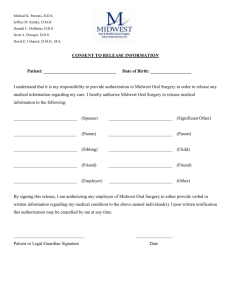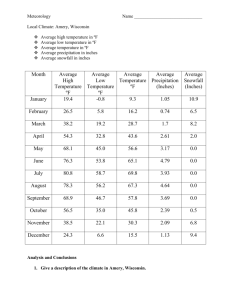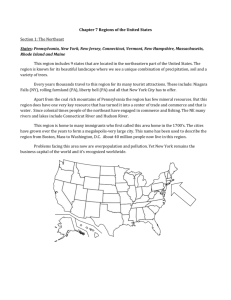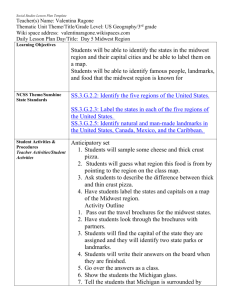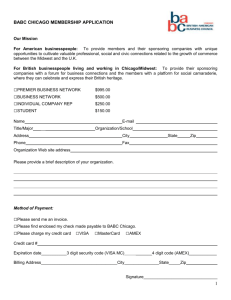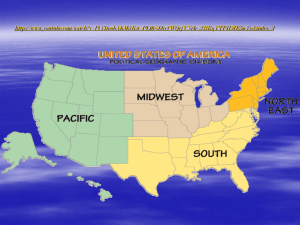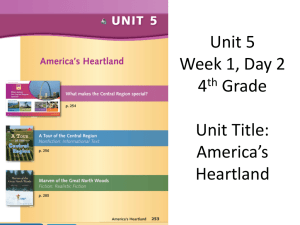Economic Review 2010 - Midwest Region
advertisement
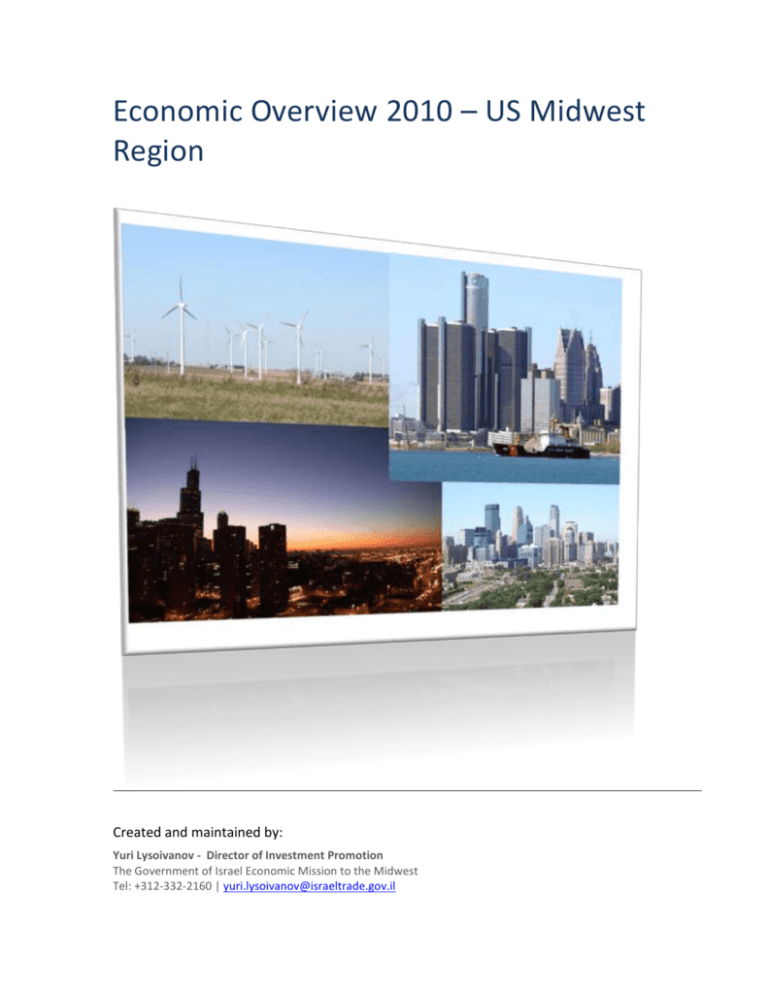
Economic Overview 2010 – US Midwest Region Created and maintained by: Yuri Lysoivanov - Director of Investment Promotion The Government of Israel Economic Mission to the Midwest Tel: +312-332-2160 | yuri.lysoivanov@israeltrade.gov.il The Midwestern United States (or Midwest) refers to the north-central states of the United States of America, specifically Illinois, Indiana, Iowa, Kansas, Michigan, Minnesota, Missouri, Ohio, Nebraska, North Dakota, South Dakota and Wisconsin (Kentucky and Tennessee are sometimes defined as part of the Midwest, and they are part of the Government of Israel Economic Mission to the Midwest’s region). The area is also referred to as "Mid-America," and sometimes as “the Heartland". Chicago is the largest city in the region, followed by Detroit and Indianapolis. Other important cities include: Columbus, Memphis, Milwaukee, Nashville, Louisville, Kansas City, Omaha, Cleveland, Minneapolis-St. Paul, Wichita, St. Louis, Cincinnati and Madison. The Midwestern States are colored orange The Midwest Region The Midwest has a population of 77,447,278 people, 25.2% of the total population of the U.S1, and accounts for 23.2% of the U.S’s GDP2. The Midwest is culturally distinct from other regions of the U.S, and is traditionally known for the rural character outside its large cities and for the industrial heritage of its urban centers. However, the Midwest is also a major center of international business activity in the U.S, with 144 Fortune 500 companies and some of the country’s largest and most famous cities. 1 2 US Census Bureau, 2009. http://www.census.gov/popest/states/NST-ann-est.html BEA 2009. http://www.bea.gov/newsreleases/regional/gdp_state/gsp_newsrelease.htm. Chicago is the economic and cultural center of the Midwest, and its metropolitan area accounted for 521 billion dollars of GDP in 2008, making it the 4th largest urban economy in the world after Tokyo, New York and Los Angeles. Put into perspective, the Chicago economy is slightly bigger than the nation of Switzerland and just below that of the Netherlands. It is the global headquarters of some of the largest companies in the world including Boeing, Sears, Walgreens, Motorola, Allstate, Kraft, Abbott Laboratories, McDonalds and United Airlines. Chicago is also a global financial center, particularly Fortune 500 companies in the in the trading of commodities and futures. Finally, Midwest Chicago is the nucleus of the American train system Illinois 31 and is the home of one of the world’s busiest Indiana 5 airports which acts as a nationwide hub for Iowa 3 domestic and international travel. Kansas 2 Kentucky 6 The Detroit metropolitan area is the next largest in Michigan 18 the Midwest, with a 2008 GDP of 201 billion dollars. The Detroit economy is slightly smaller than Minnesota 21 that of the United Arab Emirates and is about the 1 North Dakota same size as the Israeli economy. Detroit is Ohio 23 synonymous with America’s auto industry, and Wisconsin 10 hosts the international headquarters for the big Missouri 11 three domestic U.S automakers, GM, Ford and Nebraska 5 Chrysler. The city is also America’s biggest trade port, with the Ambassador Bridge alone carrying Tennessee 8 27% of the total trade between Canada and the South Dakota 0 United States. Total 144 Source: CNN Fortune 500 Minneapolis/St. Paul is the third largest metropolitan area in the region, and is home to several major U.S retailers including Target and Best Buy, in addition to large multinationals Xcel Energy, US Bancorp and PepsiAmericas3. Source: PriceWaterhouseCoopers UK 3 PWC UK City GDP Rankings 2008-2025: https://www.ukmediacentre.pwc.com Overview of Industry in the Midwest The Midwest was traditionally a manufacturing and agricultural region. However, in almost every state, conventional manufacturing is declining as jobs move to the service sector. Manufacturing has fallen from 23.5% in 1980 to 11.6% in 2008 as a share of overall payroll employment in the region, and services has increased from 21.6% to 33.9% during the same time period. This trend is illustrated on the chart below of employment in the 7th Federal Reserve District (The Upper Midwest.) Some states are coping more effectively than others, but all are pursuing policies to encourage diversification of their economies and spur job growth. Source: Federal Reserve Bank of Chicago Despite all of this, manufacturing still plays an important role in the regional economy, particularly across the swath of states known as the “Rust Belt,” which encompasses parts of Michigan, Illinois, Indiana and Ohio. For example, manufacturing still accounts for 14.6% of total employment in Indiana4. 4 Federal Reserve Bank of Chicago. http://www.chicagofed.org The most prominent example of manufacturing in the Rust Belt is the American automotive industry. The industry currently (April 2010) employs 677,400 people directly, which in 2009 accounted for 4.7% of Ohio’s GDP, 6.3% of Indiana’s GDP and 10.3% of Michigan’s GDP5. Regrettably, the recent decline in the U.S automotive sector has had a significant effect on the Midwest region. Michigan alone has lost 374,184 automotive jobs from 2005-2010. Furthermore, domestic automakers have been consistently losing market share due to foreign competition (Toyota, Honda, Nissan) and automotive manufacturing is shifting to the Southeast US, where labor is cheaper. However, the automotive industry has left behind a collection of highly trained engineers and skilled factory workers in the region, a resource that Midwestern states are trying to shift into other industries. Automotive Industry Employment: 1998 - 2008 Source: Indiana Business Review Agriculture and food processing is another important industry for the Midwest. Historically known as the nation’s breadbasket, the Midwest is home to some of the most productive farmland in the U.S. and is divided into three distinct Agricultural areas6: Lake States (Minnesota, Wisconsin, Michigan) – Grains and dairy Corn Belt (Illinois, Iowa, Missouri, Indiana, Ohio) – Corn, soy, beef, feed grains, dairy, livestock. Northern Plains (North Dakota, South Dakota, Nebraska, Kansas) – Wheat, other grains Kentucky and Tennessee are part of the Appalachian farming area, which grows the majority of tobacco and peanuts in the United States. 5 6 Indiana Business Review. http://www.ibrc.indiana.edu/ibr/2010/spring/article2.html United States Department of Agriculture. http://www.usda.gov The abundance of farmland makes the Midwest a prime location for major food processing and distribution networks. The following multinational food and agriculture companies have their headquarters in the Midwest: Monsanto (St. Louis, MO) – Herbicides, Pesticides and Crop Seed Archer Daniels Midland (Decatur, IL) – Food & Grain Processing, Beverages, Feed, Ethanol Cargill (Minneapolis, MN) – Food & Grain Processing, Livestock, Pharmaceuticals ConAgra (Omaha, NE) - – Food Processing, Distribution Chiquita (Cincinnati, OH) – Food, Bananas Kellogg (Battle Creek, MI) – Food & Grain Processing Kraft Foods (Chicago, IL) – Food Processing, Distribution, Beverages General Mills (Minneapolis, MN) – Food & Grain Processing Modern Sectors in the Midwest Although agriculture and manufacturing have traditionally been the staple industries of the Midwest, the large amount of prestigious universities in the area and the push for diversification have created a strong industry presence in services, finance, high technology, health care and green technology. In 2008, services, trade and finance accounted for 60.4% of all non-farm employment in the Midwest. Illinois, the most populous state in the Midwest is a prime example. The state’s service sector alone employs more than 2.38 million people. Chicago is the epicenter of this activity and the city is the second largest financial center in the US, after New York City. It is home to over 2,300 commercial banks, nearly 1,000 savings institutions, 500 credit unions and 2,000 Insurance carriers, including international companies State Farm and Allstate7. Chicago is also the global center of commodities and derivatives trading. Outside Illinois, Minneapolis-St. Paul, St. Louis, and Kansas City also serve as important regional financial centers. Hi-tech and Biotech also have a strong presence in the Midwest. Chicago is home to many of the largest pharmaceutical companies in the world including Abbott, Baxter, Hospira and Takeda. Indianapolis has been the home of pharmaceutical giant Eli Lilly since 1876 and Cincinnati has been home to consumer goods giant Procter & Gamble since 1837. Minnesota is a global center for medical devices, and St. Louis is known for its strength in agro-technology. Telecommunications are another big Midwestern industry. Leading companies Motorola and U.S Cellular are based in Chicago, while Sprint is based outside Kansas City. The most active states in 2009-10 for trade and promotion of business with Israel have been Ohio, Illinois, Michigan, Minnesota and Wisconsin. Recently, Israeli companies have participated in regional events in the biotechnology sector, water technology sector, automotive sector, IT sector, food services sector and more. 7 State of Illinois Business Portal. http://business.illinois.gov Recent Trends “Green” manufacturing is commonly seen as one of many solutions to the issues of rising unemployment and the shrinking traditional manufacturing sectors. Across the Midwest, states and municipalities are providing tax credits and incentives to foster green industry growth. Toledo, a town in Ohio, is an illustrative example. A former hub of glass and automotive manufacturing, Toledo is remaking itself as a center for solar technology. State grants have provided incubator support for new companies and the local business community has banded together to provide venture capital for new startups. Today there is a successful cluster of solar companies operating out of Toledo, providing over 6,000 jobs. Additionally, Ohio has also approved a mandate that requires 12.5% of the state’s electric power to come from renewable sources by 20258. Water technology is another green industry being embraced by Midwestern states. Both Wisconsin and Michigan have state initiatives to promote the development of the water technology industry, and both states have signed agreements with Israel stipulating research cooperation in this sector. Michigan’s Green Jobs for Blue Waters program resulted from the Memorandum of Understanding that Michigan’s Governor Granholm signed in 2007. The program focuses on industrial, agricultural and residential water use with the goals of assuring clean and sustainable water resources for the state and region. The memorandum outlines the following goals: promoting and developing ecosystem restoration technologies, promoting the efficient use and re-use of water resources and developing and expanding the water-technology supply chain to export these technologies globally from Michigan. Wisconsin is promoting similar state sponsored programs in order to turn it into a hub of fresh water technology. A school of freshwater science is opening in Milwaukee, Wisconsin’s largest city. Milwaukee and Cleveland are an innovator and a signatory, respectively, to the UN Global Compact City Program for water technology. Working with the Midwest The opportunity is ripe to capitalize on the Midwest's interest in partnering with Israel. It is a mistake to overlook the Midwest in favor of the coasts when looking for export opportunities, joint ventures, or foreign direct investment. Home to diverse population centers, multinational companies, skilled populations, large Jewish communities, and generally cheaper office and manufacturing space, the Midwest is the perfect point of entry into the U.S market. We at the Government of Israel Economic Mission are here to help you! 8 Ohio EPA, 2010. http://www.epa.ohio.gov Source: http://www.bea.gov/newsreleases/regional/gdp_state/gsp_newsrelease.htm Sources Global City GDP Rankings. (2009, February 11). Retrieved July 7, 2010, from PriceWaterhouseCoopers UK: https://www.ukmediacentre.pwc.com Population Estimates. (2009, July 1). Retrieved July 7, 2009, from US Census Bureau: http://www.census.gov/popest/states/NST-ann-est.html Climate Change and Ohio. (2010). Retrieved July 8, 2010, from Ohio EPA: http://www.epa.ohio.gov/dapc/climatechange/ccohio.aspx Fortune 500. (2010). Retrieved July 6, 2010, from CNN Time Warner: http://money.cnn.com/magazines/fortune/fortune500/ Illinois- Access to Key Industries. (2010). Retrieved July 7, 2010, from State of Illinois Business Portal: http://business.illinois.gov/io_keyIndustries.cfm BEA. (2009, June 2). Regional Economic Accounts. Retrieved July 7, 2010, from Bureau of Economic Analysis: www.bea.gov Structure of U.S. Agriculture. (n.d.). Retrieved July 7, 2010, from USDA Factbook: www.usda.gov/news/pubs/factbook/fb002.pdf Testa, W. (2009). Employment by Industry Sector for 1980-2008. Retrieved July 7, 2010, from Federal Reserve Bank of Chicago: http://www.chicagofed.org/webpages/communities/midwest_economy/employ ment_by_industry_charts.cfm Thompson, M., & Merchant, A. A. (Spring 2010). Employment and Economic Growth in the U.S. Automotive Industry. Indiana Business Review, 10-17.
